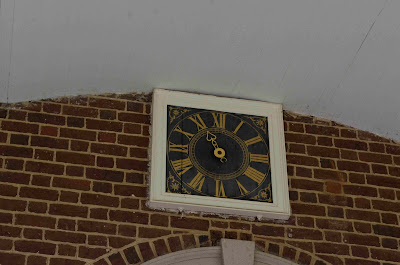We started our day with the introductory movie which gave us background on Jefferson and Monticello. During the course of our day we did the General House Tour and finished with the new Behind the Scenes tour. We learned Jefferson inherited the land from his father but it was debt ridden. He increased the debt even more through his lifetime by his ceaseless purchase of books, his supporting of family members, extended family members and friends' family members. Most of his income came from growing wheat and tobacco.
Jefferson's wife, Martha, died after they were married ten years. Two of their six children survived to adulthood but only his daughter Martha, who as a young girl took over the duties of running the household, lived a long life. She and her somewhat estranged husband had eleven children. Except for the husband, they all lived at Monticello along with various other relatives and the family of his best friend.
Monticello means little mountain in French. Jefferson chose the name for the hill upon which he placed the home which he continually rebuilt over the forty years he lived there. He considered his home an “essay on architecture.” He and his family lived in a one room house during construction.
The main house was expanded and raised to three stories.
No photos are allowed in the home. The house was designed, remodeled and expanded during Jefferson’s time. It is primarily Ancient Roman style. He was always finding new ideas to try including such innovations as self closing doors and double pane windows. There are twenty-one rooms in the home, twelve of which are bedrooms and several of those have alcove beds (beds in spaces between rooms or cut into walls.
Above the entry, a one-hand clock designed by Jefferson still keeps accurate time. On the inside of the house, the other face of the clock is a seven day grandfather with its pendulum. The clock is attached to a gong at the top of the house which, when it chimed the hour, could be heard miles away. Inside the house, the days of the week are marked on the wall but Jefferson ran out of wall space as the week went on so Saturday is downstairs below floor level.
Inside the front door, the entry is filled with collections including Native American arts (now recreated) from the Lewis and Clark expedition, antlers, skulls of American mastodons and other curios. Ninety percent of the furnishings are intact and look like they were ready for the family to use them.
Jefferson was addicted to books. His library originally had over 7000 books. After the British burned Washington in the War of 1812, he needed the money and sold 6700 volumes to form Library of Congress. He immediately started buying more books and, at his death, there were one thousand volumes in seven languages,
His desk has his polygraph, a device to write two letters at one time so that, for every letter he sent, he had an original copy. He had five books on a spinning rack for easy access.
The paintings in drawing room include founders of America, three presidents, and his good friend, the Marquis de Lafayette. Alexander Hamilton and Jefferson opposed each other in life and he placed the busts opposite each other so they could continue to oppose in death.
The dining room is set for buffet style serving. He adopted the taste for French cooking and had one of his slaves trained in France. (That man was later freed and taught other slaves to prepare French food.) A door with shelves spun like lazy Susan so slaves stayed out of sight while guests dined.
Jefferson and his wife each had an alcove bed in their room. The bed basically was tucked into the wall to provide more floor space. Bedrooms, except the Jefferson and his daughter, were shared by two to six people. The octagonal guest room was called Mr. Madison’s room because of the James Madison’s frequent visits.
On the top floor is the Dome Room with lovely views of the grounds. This was the only room in the house where photos were allowed.
Jefferson’s granddaughter, to get away from responsibilities, hid in this “cubby” with some of the other young adults.
The pine doors are stained to look like mahogany.
The woodwork (all done by slaves) is remarkable and demonstrates the quality of the labor that existed at the time when there were no power tools and all work was done by hand.
Throughout his life Jefferson was deeply in debt. He had four generations of family as well as friends dependent upon him. He like to give lavish dinners with expensive French wine. After his death, Jefferson’s grandson worked to pay off the debts. At his death, he owed more than $100,000.00 (about 2.5 million in today's money). The grandson was forced to sell the slaves six months after Jefferson’s death. The Barclay family ultimately bought the house but were unable to maintain it. After succession the Confederacy took the house but did nothing with it. At the end of the Civil War, Uriah Levi, a Commodore in the U. S. Navy bought the home not to live in it but to preserve it. His strong admiration for Jefferson stemmed from Jefferson's writing the Virginia Statute for Religious Freedom and his views on religious tolerance. In 1923 his nephew Jefferson Monroe Levi deeded the home to the Thomas Jefferson Memorial Foundation to be preserved and to welcome visitors to learn about this complex man. It is also a UNESCO World Heritage Site.
Part II of our visit to Monticello will be in our next post.










No comments:
Post a Comment